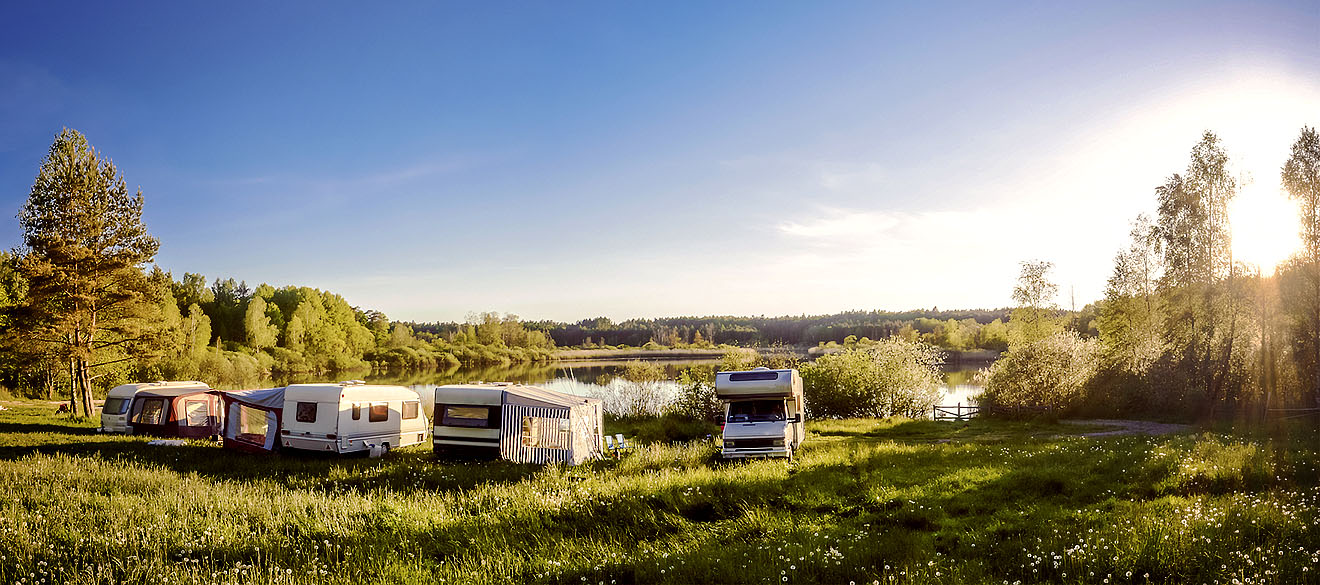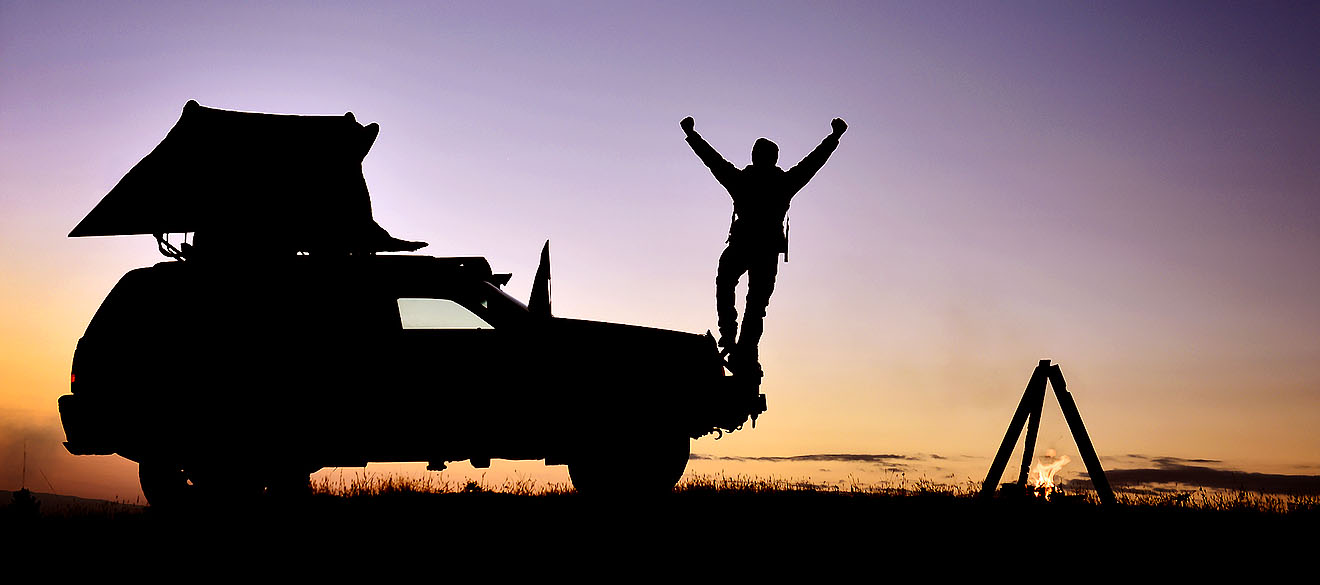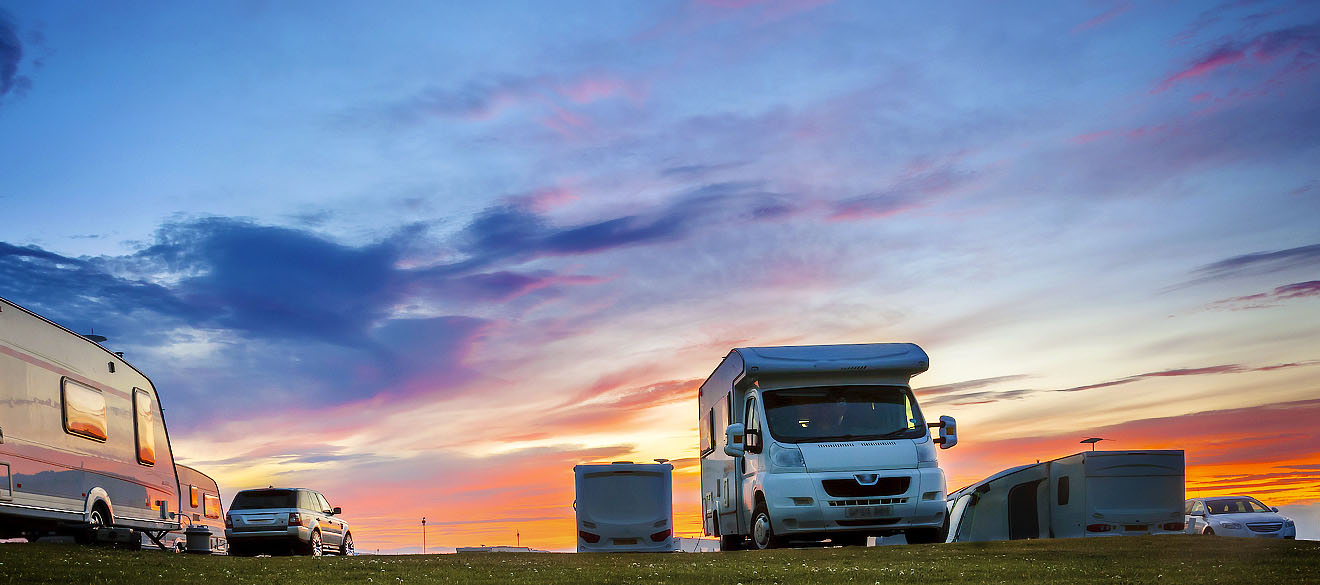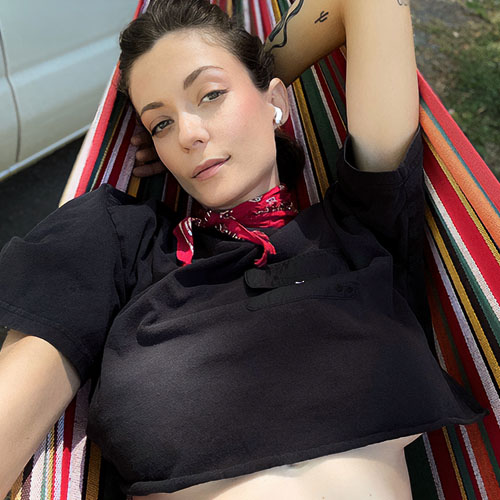How more and more Americans are taking to the road and making a vehicle their home.
There’s a fireball sunset blazing on the western horizon of Arizona’s Sonoran Desert. As a cool January dusk settles over this ashy plain outside the town of Quartzsite, two hours west of Phoenix on Interstate 10, I’m sitting before a campfire in this infinite land, being initiated into a tribe I only recently discovered but which has welcomed me.
All around us in the fading light, between the saguaro cactuses and creosote bushes, are a few thousand vehicles—our homes. We’re nomads. We’re people from all walks of life, from all over the country, who have chosen to remain in motion and live out of our campers and vans, our converted box trucks and school buses, our road-warrior RVs, and even our cars, the smallest of these mobile dwellings.
We’ve gathered for the tenth installment of the Rubber Tramp Rendezvous, a convocation of highway roamers—“rubber tramps”—that began in 2010 with just 45 attendees, but now nearly doubles the 3,500-resident population of Quartzsite during its two-week run.
Pre-Rendezvous, Quartzsite, the “Rock Capital of the World,” had been known for its winter gem and mineral shows, a desert mecca for rock hobbyists. But for those seated around this campfire, as well as for our neighbors inside or outside their vehicles, it’s this annual encampment that put the town, not far from the California border, on the map.
It’s time for campfire introductions. “Elle, wandering writer, gray Toyota Sienna,” I say on a rapidly cooling evening. More brief bios pour forth from trampers accustomed to meeting others on the road and sketching their lives in a few words.
Julia is a freelance social worker and lifestyle “minimalist.” Easy is an itinerant agriculture worker, father to a pit bull. Brad is an unemployed van dweller. Polly Rose—whom I immediately decide is fabulous—is a full-time trailer tramp. Tabi? A former B-movie actress and free spirit. Jon is a grieving father. Hollywood is a rock hound, an amateur geologist. Footloose and house-free, J.J. and her partner Kevin are classic twenty-first-century rubber tramps.
With the country in the midst of the longest shutdown in government history, we’ve been left to our own devices on this tract of federal land. Not that it matters—America shut down for most of us a long time ago. The coming together, here, of road-hardened misfits shows the increasingly imaginative, and dedicated, lengths to which people will go to be free, in the land where freedom is supposed to be a given.
More and more Americans are living in their cars. I am one of them.
In early 2018, I was trying to scratch together a living as a writer when a friend (who too often sheltered me) passed along YouTube videos of people converting old vans into something resembling tiny homes. Over the past ten years, a new breed of hobos and dreamers emerged from the Great Recession that hit in 2008. Like our freight-hopping forebears, rubber tramps have taken to roaming America on wheels, looking for work, kinship, or simply trying to outrun despair.
My sometime partner, Joseph S. Furey—a writer and veteran freight hopper himself—was similarly crisscrossing the country on his own steam. He offered me a simple, conceptual sleight of hand to help me on my way: You can’t be homeless if you consider the road your home.
For two weeks, this nowhere land outside of Quartzsite is the closest thing we have to a settled living situation. And my next-door tramper, Polly Rose, 63, is intent on creating a temporary neighborhood. Our nightly campfire circle takes place in front of her battered trailer, which she’d unwittingly driven the last 50 miles on two blown rear tires. Polly had taken to the country’s interstate system as a way of cleansing her life, and escaping the elements of herself that she fears she has passed onto her children.
“I just had enough,” she says, rolling a prodigious joint laced with peppermint oil for an uncertain health benefit. “I did as much as I could, and I left.”
Polly Rose ditched her husband’s last name—her wasband, she calls him—bought some new teeth, and rented out her house on the proviso that her alcoholic son could move into the basement. The small trailer that’s now her home is papered in aphorisms and love notes. Beneath her bed, which occupies much of the vehicle, she keeps bags of wigs, tutus, and tiaras, and as the winter sun sets, she pulls out these bags for our benefit.
Every night we gather for the same ritual. We play dress-up, I suspect, so that Polly Rose can learn to be herself again. Around midnight, we stumble from the dying fire across the desert washes to the white tents of Party-R, a disco encampment that to Polly Rose represents a Shangri-la she knows is out there waiting for her.
For others in our lot, the very existence of Quartzsite is oasis enough. Along with its rock reputation, the town calls itself the world’s boondocking capital. (“Boondocking” is a word for camping out in your RV.) Some two million road warriors pass through in non-summer months.
For everything we lack, we trampers are rich in beliefs—and perhaps more importantly, we have a faith in beliefs.
Our nightly campfire smokes out everyone’s life philosophies, wisdom sources, rituals, and theories. People share encouraging epigrams, and speak of credence in the ability to manifest small riches (such as a cheap camper) into being, and the inherent goodness of the universe. Some cite the golden rule. The power of positive thinking. Tarot cards. Mushroom hallucinations to take you into a past life. Constellation therapy. Chemtrails. Gong therapy. People share their views of God, too, if they believe in God. It’s a grab bag of perspectives. When you live on the road, an openness to belief helps keep you going, especially when it enables self-belief. And when you’re living in your car, self-belief is key.
THERE are three types of rubber tramps at this gathering: those who are here by necessity, those who had enough life stability to make the choice to come, and those who tramp as an ongoing lifestyle. The latter are the snowbirds—well-off Northerners escaping the winter cold in RVs the size of tour buses. They populate the local motor home parks, equipped with electric and water hookups, scattered around town. The rest of us “dry camp”—meaning we set up shop without hookups—for free in the rocky outskirts governed by the Bureau of Land Management. Jon and Hollywood have already been out here for months, hoping to find themselves a Polly Rose to ward off loneliness.
The dry campers in our group have nomadism in common, but there’s some variety in our “homes.” If Polly Rose’s trailer is basically a steel shell for her bed, my minivan offers even tighter quarters. The cargo area is exactly seven-and-a-half feet with the back seats taken out. Still, it’s big enough to hold a full-size mattress topper, my belongings, and a portable bucket toilet.
I call my van Dapple after Sancho Panza’s donkey, deciding it’s the companion to Rocinante, John Steinbeck’s name—inspired by Don Quixote’s horse—for his overloaded camper truck in his 1960 bestseller, Travels With Charley. The aging novelist and his dog, a standard poodle, set off in search of the “real” America, if there was ever such a thing.
My Dapple is a faithful beast, which I equipped for the road as best as I could. I studied YouTube videos detailing this kind of vehicle makeover created by Bob Wells, the 63-year-old spiritual leader of trampers and founder of the Rendezvous. Per his instruction, I shaped sheets of silver Reflectix to my windows for insulation and privacy, painting one side black so as to not draw attention to my van wherever I stopped at night.
Further touches for my foil-lined crib are equally practical. I bought bedsheets the color of red wine, boxed red wine itself, cans of mac and cheese, Mace, a knife, and a bottle of extra strong sleeping tablets. An Australia native, I rolled out for a life touring a realm inside my adopted country—a land of interstate highways, strip mall parking lots, and overlit truck stops, and one requiring no permit for entry, just a homey steel vehicle.
Though I’d become a tramp out of economic necessity, I’d come to believe I was earning my living, such as it was, writing about a country I wasn’t sure I fully understood, and I wanted to learn more. John Steinbeck set out to discover what Americans were like at the start of the sixties, his instincts telling him that the country he’d been chronicling for decades was on the cusp of great change. My project was a little less grand: I wanted to explore some of the things about America we weren’t being told.
ON my second day in Quartzsite, a new neighbor joins the fold. Joni, 61, is a refugee from Paradise, California. Back in November, as her hometown fell prey to one of America’s worst wildfires in a century, Joni’s uninsured home turned to ashes.
“When [the fires] came, there were four exit points, and we were supposed to be evacuating zone by zone,” she remembers. “But one of the zones was immediately engulfed in flames. There were embers everywhere, and then Paradise was all on fire at once. People couldn’t get out of their neighborhoods for the traffic jams. They were running out of gas in the gridlock on the roads. People were dying in their cars.”
Joni’s hair is tied back with a repaired elastic; her face carries enough exhaustion for two. A longtime pet rescuer, she was not at all sure, when the inferno came to Paradise, that she’d be able to rescue herself. She did get out, but lost almost everything, and keeps remembering what it was like to feel so helpless, gripped by such fear and horror.
To make matters worse, not only did the federal government give little early help to the survivors of Paradise, but it compounded their grief in the weeks afterward. Residents who had been living in RVs, tents, and cars among the ashes of their former houses were evicted, as FEMA ruled from Washington, D.C., that it would stop funding the cleanup, on the logic that if people were living there, it couldn’t be an emergency.
“I couldn’t bring myself to stay in Paradise, anyway,” Joni says, trying to calm her anxious dog, Angel. “When things didn’t work out at my sister’s, I was camping out in the Cali desert. A friend told me about the Rubber Tramp Rendezvous, and it felt like serendipity.”
Few would say that life on the road arrives by good fortune, but for someone like Joni, it offers something important—choice. Forced to start over, needing to make a new set of life decisions, Joni reevaluated things she’d always been told she should want.
“Consumerism as a way of life—as a way of entertaining ourselves—is something I’ve been very uncomfortable with for a long time,” she says. “On top of that, one of the factors keeping me mobile is that I don’t want to ever have to uproot and leave again if things get nuts. I’m not escaping civilization per se, but I can’t trust a place will be there anymore.”
Joni adds, “The idea of being fluid, being able to move with the climate and the weather, is now the most important thing to me. And I want to see places before I’m gone and before they’re gone. I want to be dwelling on the positive rather than the negative grind of keeping a roof over my head. The fire crystalized the challenge of our time.”
After a pause, Joni shares a final thought:
“I’ve always looked rather askance at the American Dream—I saw it as a trap. Even though I tried to get there, I knew it wasn’t something that was terribly attainable for me. I was around the edges of its trappings. And now I know that isn’t anywhere at all.”
THE term “American Dream” was coined in 1931, by the author of a book called The Epic of America—ironic timing, since the Great Depression was starting to destroy this dream for so many. But the idea behind the term is one as old as the founding of America itself—this seductive notion that there is equality of opportunity for all in this country, and that those who pull themselves up by the bootstraps can make anything of their lives.
What’s not mentioned is what underpins the Dream—a toxic culture of competition. As I watched the future American president repeating phrases about winning over and over during his election campaign—We’re going to win. We’re going to win so much. We’re going to win at trade, we’re going to win at the border. We’re going to win so much, you’re going to be so sick and tired of winning—I sensed this was something unique, this relentless focus on winning, and uniquely destructive, to the country that was my new home.
The chasms that exist in America—between the races, genders, rich and poor, urban and rural—are broadened by a culture that is obsessed with competition. The great disturbance in American society rests on this fault line between winners and losers—a divide that’s becoming increasingly pronounced.
The World Values Survey, a global research project studying the beliefs of people in different countries, shows that Americans esteem competition like no other industrialized nation on Earth. Americans believe more strongly in the fairness of unequal outcomes. Author and social commentator Fran Lebowitz says there’s an idea running throughout American society: “All people who succeed, succeed on their own, and all people who fail, fail on their own.”
This viewpoint has become a shared fiction on an epic scale. The values anchoring it are as engrained as a verse from the Good Book—a verse anyone can preach, because everyone knows it. But competition, and the importance of winning, create more than just a belief system. These intertwining strands form the double helix of modern America’s DNA.
Historian Scott Sandage views this American way of life as a “eulogy to capitalist identity.” The conviction that there must be winners and losers dates back to the nineteenth century, when entrepreneurial spirit and the ideal of the self-made man spawned a society dominated to a great extent by the values of business and finance. These values have just grown, gotten more inveterate, more layered, leading to society today, where the discourse of finance is everywhere, and we’re judged as people by our credit ratings. Sandage calls this a situation where “the language of business [is] applied to the soul.”
Americans are unhappily locked into a culture of inequality—yet are optimistic about their personal chances of climbing up the ladder. A scholar once summarized Steinbeck’s take on this by saying the writer viewed America as a country of “temporarily embarrassed millionaires.” In other words, the average citizen might not be proud of his or her circumstance, but believes that by pursuing the Dream, he or she will eventually access millions, and financial embarrassment will vanish. Steinbeck, who spends much of Travels With Charley driving around lost, came to conclude that America itself was lost, its culture off-track—but this was an America simply being true to its animating values.
The hope of equality for all has taken a big hit since Steinbeck’s journey. Loserdom is rife in a land where everyone is taught to be a winner. But out in the Sonoran Desert, a community is trying to do things differently. Whether by consciously abandoning the American Dream—or by having slipped into a financial situation where the Dream abandoned the American—we are setting out to define success on our own terms.
J.J., 43, and Kevin, 47, saw both of J.J.’s parents die shortly after they retired. “I remember a week or so before she passed,” Kevin says, “J.J.’s mom was crying, saying it’s not fair she didn’t get to do those things she had worked her whole life for.”
“We thought about what was important to us,” J.J. adds. “What do we want to do in this life? We wound up asking why we are working so much, when it’s just to buy more stuff.” They ended up selling that stuff in Denver, where Kevin worked as a mechanic and J.J. managed apartment buildings, and bought a van they named “Shirley B,” after J.J.’s mother.
“The Dream in the generic sense is this spoon-fed idea we all know, but I still think this country is big enough to dream different kinds of dreams and go after them,” J.J. says. “People express a lot of fear when they ask us what we are doing. Leaving security is a real fear—but it’s a fear that people are feeding themselves.”
Like the rest of our campfire gang, J.J. and Kevin have survived to this point on what small financial security they had cobbled together. But most rubber tramps can only live for so long on savings, other money scraps, and disability pensions. Eventually, they’ll join the tens of thousands of fellow van dwellers on the itinerant work circuit.
There’s now a whole unsung economy dependent on the labor of rubber tramps: the sugar beet harvest in North Dakota, where two weeks of hard work can generate up to $4,000 per person; Amazon’s Camper Force warehouses across the South and Midwest that only employ van dwellers; and the myriad RV parks around the country that give free hookups and small living allowances to tramps who look after park administration and maintenance.
At a Rendezvous seminar on working as a rubber tramp, one speaker notes the critical distinction it gave his life, elevating him from homeless to houseless. The disadvantages of this kind of work are familiar even to some people who work regular jobs in 2019, depending on their positions—the lack of real job security, long hours, and no health insurance. Despite these challenges, it’s hard to find anyone on the road with a bad word to say about the mechanics of the roaming labor market—in part because it is exploitation on their own terms, and that kind of small psychological victory is important.
FOR all of the false promises folded into the idea of the American Dream, however, running toward the alternative provides nothing greater in terms of assurance.
Jess arrives at our camp one night, her eyes large under the vast desert sky, with a physical beauty often rewarded by the conventional world. A dental nurse in D.C., the 28-year-old, stuck in traffic one day, said “Fuck it,” packed her things, and left for the Appalachian Trail. More wanderer than hiker, she later hitched south for the winter.
“I can’t go back there if I drink,” she says, gesturing over the wash with one of Polly Rose’s joints in her hand. “I was rained out of my tent, and this guy took me into his trailer.”
Jess has no money, no phone, and her already precarious mental health is being stretched thin by living on her looks. She can’t even afford to be a regular rubber tramp, and was taken in by a Scottish reiki master twice her age. Our quiet conversations about how to help Jess degenerate with the booze and the desert air. She disappears in a fury.
I can’t shake the feeling that Jess had wanted to join me on the road, if only because I could offer a degree of safety as a woman of similar age, and would ask for nothing in return. I’ll end up spending my last Rendezvous day searching for her, while feeling troubled by the thought that I might not to be able to handle the responsibility of sharing the road with her, and might not be able to trust her. Adding to my fret is the recognition that I was in this desert to celebrate failure at playing the conventional American Dream game, yet here I was falling into the trap of judging this failure in Jess.
IF Jess is unlike most of the Rendezvous millennials here mainly to party, she is no less representative of America’s young people. This event skews to plus-65 boomers, but there is a growing number of millennials—those born between 1981 and 1997—who have taken to the road.
So-called “losers” are not only getting younger, but their beliefs are moving further away from core national ideals. It’s little wonder that in a 2015 survey by Harvard’s Institute of Politics, half of millennials said that the American Dream is dead.
Millennials represent the first generation to be poorer than the one that came before them. The rise in freelancing means lower job security across the board, and reduced access to health care. Those with more stable prospects are still suffering from skyrocketing student-loan debt and housing costs. Add to this the fact that millennials have to worry about the damage of climate change looming in their lifetimes.
Content to “fail” by conventional measures in order to “succeed” on our own terms, millennials are redrawing the definition of a good life. That’s easy enough for someone like me, whose race and background give me an advantage in terms of cultural acceptance. But there are a lot of people living in a situation contained by America’s geographic borders who might as well exist in some kind of nightmare alternate dimension.
Poverty and homelessness are affecting minorities in greater numbers, yet the Rubber Tramp Rendezvous is decidedly white. Julia, the freelance social worker who’d become something of a spiritual guide to our group, is mixed race, but says she’s “white-passing enough” to live on the road. With that said, she adds, “I wouldn’t let my sons do it, though.”
Despite the predominantly white rubber tramp culture, one of its rising YouTube stars is the African-American Ms. J. Ms. J left her job in marketing in Los Angeles three years ago, and now spends her days being paid to drive RVs to dealerships across the country.
“I’m one of those people who doesn’t conform to the norm,” Ms. J tells me. “I tend to try to break down barriers, and not all black people think that way. I think a lot of people know the historical risk of violence from being with white people—those things are still in the minds of people who lived it, or passed that history down to the next generation.”
Not long after Ms. J discussed breaking down barriers and encouraging Americans of different races and ethnicities to embrace life on the road, six California police officers shot 20-year-old African-American Willie McCoy to death in a Taco Bell drive-thru. An employee had seen him slumped over in his car and called the cops. McCoy had fallen asleep.
The Great Recession might have ended for Wall Street, but it has barely slowed for Main Street. Homelessness in America has grown exponentially since President Reagan halved the federal budget for housing in the 1980s, and the economic tsunami of 2008 and its aftereffects only accelerated the crisis in affordable housing.
Just as the Great Depression led to people taking to the rails to hop freights, the Great Recession saw people moving into their cars. Unfortunately, the law also moved with them.
The National Law Center on Homelessness and Poverty has monitored 187 of the largest cities, and seen an alarming increase in the criminalization of houseless living. Some 39 percent of cities now prohibit residing in vehicles—an increase of 143 percent since 2006.
“Ninety percent of the nation’s housing is affordable to ten percent of population,” says Tristia Bauman, senior attorney at the NLCHP. “The majority of the country is just one emergency away from a slide into homelessness.”
Bauman recently won a major victory, overturning laws in San Diego that made it illegal to live in cars, in a case she hopes will set a precedent for other cities.
“Laws criminalizing living in cars and RVs,” she tells me, “are usually passed as a reaction to visible homelessness and poverty. These laws disproportionately target the most vulnerable in society, such as the disabled, people of color, and immigrants with families—because, quite simply, they are most likely to find themselves on the streets.”
Cracking down on the homeless usually begins as local community pressure. A home is seen to embody the values of hard work and self-sufficiency, while homelessness is a billboard for failure. But when so many people in homes have it little better than us on the road, when the middle class is evaporating and the working class has become the working poor, I wonder how much of this community pressure is driven by resentment of our perceived freedom.
That, of course, is little comfort to our brothers and sisters who can’t afford the gasoline, or won’t risk the road to go to Quartzsite. As those of us sitting around the campfire raise glasses to our freedom, rubber tramps are being pushed further and further into the margins.
IN ways Henry Ford couldn’t have imagined, the car remains fundamental to the American way of life. This gathering in the desert makes it clear that becoming a rubber tramp means more than piecing together a living. It’s a tiny act of defiance against the stagnation of economic life for those participating in the mainstream home-and-job existence.
Drifting in the trampers’ undercurrent, I traveled some 22,000 road miles in ten months. During this long period of sleeping in Walmart parking lots, grabbing stealth “showers” in gas station bathroom sinks, and exploring backwater towns, I had been slowly losing my attachment to the comforts I thought were necessary to a good life. And even here in Quartzsite, surrounded by a ring of jagged mountains, my eye remains trained on the horizon. To know there is always somewhere else to go is a hell of a tonic.
For waifs and strays, taking to the road is an instinctive reaction to everything that is lacking in one’s life, including opportunities for social mobility, as well as to the rigidity of a normal working existence, and the stifling anxiety of never quite being able to make ends meet. When everything is fucked, you might as well bet it all on Jack Kerouac, throw caution (and comfort) to the wind, and become a part of the mythos of the road.
ON the last night of Rubber Tramp Rendezvous 2019, we try to enhance that mythos, gathering at a central bonfire where we ritually ignite a small cardboard van, an RTR tradition, and sing our theme song to the tune of Willie Nelson’s “On the Road Again.”
The crackle, flames, and music couldn’t soothe my troubled mood, as Jess was still on my mind, so I did a final round of searching for her. Our campfire group outside Polly Rose’s trailer appears to have been the last people to have seen her. Someone did suggest, though, that she was hitching west to Slab City, a California anarcho-encampment on an abandoned Navy base.
Back at our own campfire, what’s left of the group convinces Polly Rose to stay on with them for her sanity—and theirs. J.J. and Kevin are preparing to cross the border to Mexico for affordable dental work, as other trampers have done. Hollywood seems ready to resume his days of digging for gems, and his nights posting on Facebook about being lonely.
Just before I roll out the next morning, we get word from Joni, who left days earlier. Her disaster check from FEMA arrived at her brother’s place, and she is about to use the money to buy a secondhand RV. A few weeks later she calls me, ready to begin her new life on the road, with only the hot springs of New Mexico in her sights, and music by Janis Joplin in her head.
“I have the freedom she sang about now,” Joni says during a phone connection that can’t quite keep up with our conversation. She’s referencing a song from 1970, “Me and Bobby McGee,” where Joplin sings, ”Freedom’s just another word for nothin’ left to lose./ Nothin’ don’t mean nothin’, hon, if it ain’t free, no no.” And Joni, former resident of Paradise, California, adds, “I’m not going to say that I’m grateful. But I’ll take it.”
Elle Hardy is a writer wandering the South of the United States. She hails from Australia and has reported from countries including North Korea and Turkmenistan, but lately America has her affection and attention.
























Joni sent me this. It’s well written, Elle. Nice insight into a slice of the American Pie that few ever taste